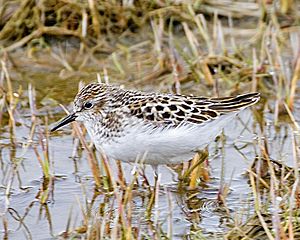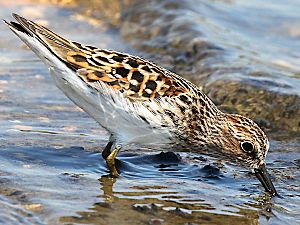Least sandpiper facts for kids
Quick facts for kids Least sandpiper |
|
|---|---|
 |
|
| Summer plumage | |
 |
|
| Winter plumage | |
| Conservation status | |
| Scientific classification | |
 |
|
| Synonyms | |
|
Erolia minutilla |
The least sandpiper (Calidris minutilla) is the smallest shorebird in the world. It's a tiny bird that lives near water. Its scientific name, Calidris minutilla, comes from old words. Kalidris was used by Aristotle for grey waterside birds, and minutilla means "very small" in Medieval Latin. This name perfectly describes this little bird!
Contents
About the Least Sandpiper
This bird has greenish legs and a short, thin, dark bill. When they are ready to breed, adult least sandpipers are brown with dark streaks on their backs. Their bellies are white. They have a light line above their eye and a dark cap on their head. In winter, they look more grey on top. Young least sandpipers have bright patterns with reddish-brown colors and white stripes on their backs.
It can be tricky to tell this bird apart from other small shorebirds. These tiny birds are often called "peeps" or "stints." The least sandpiper looks a lot like the long-toed stint from Asia. However, the least sandpiper is more compact and has a shorter neck. It also has shorter toes, slightly duller colors, and a stronger wingbar.
How Big Are They?
- Length: 5.1 to 5.9 inches (13 to 15 cm)
- Weight: 0.7 to 1.1 ounces (19 to 30 g)
- Wingspan: 10.6 to 11.0 inches (27 to 28 cm)
Breeding and Migration
Least sandpipers breed in the northern parts of North America. They make their homes in cold, treeless areas called tundra or in wet, spongy lands called bogs. They build their nests on the ground, usually close to water.
Life Cycle and Nesting
The female least sandpiper lays four eggs in a shallow dip in the ground. This nest is lined with soft grass and moss. Both parents help to incubate the eggs, keeping them warm until they hatch. However, the female often leaves before the young birds can fly. Sometimes she even leaves before the eggs hatch! The baby birds can find their own food. They are also able to fly within two weeks of being born.
Where Do They Travel?
These birds migrate in large groups. They fly south for the winter to warmer places like the southern United States, Mexico, Central America, the Caribbean, and northern South America. Very rarely, you might see one in western Europe.
What Do They Eat?
Least sandpipers look for food on muddy areas near water. They mostly pick up food they can see, but sometimes they also probe into the mud with their bills. Their main diet includes small crustaceans (like tiny crabs), insects, and snails.
See also
 In Spanish: Menudilla para niños
In Spanish: Menudilla para niños



